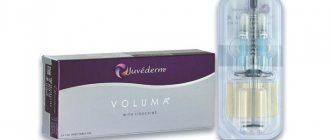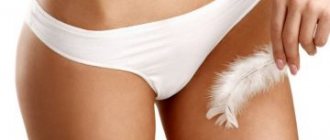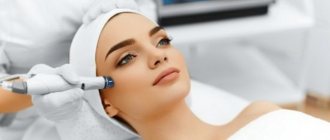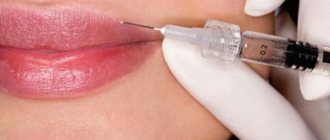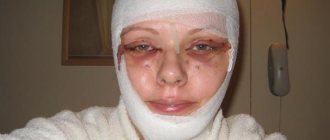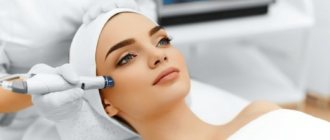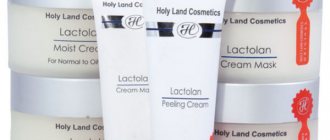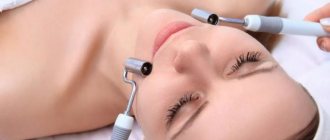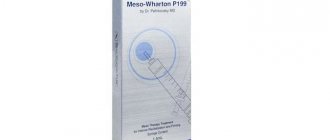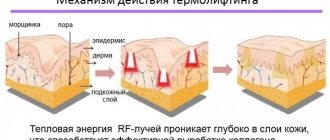Author
Kulova Zhanna Borisovna
Chief cosmetologist
Cosmetologist
Cryodestruction is a method of removing tumors on the skin, which is based on the use of liquid nitrogen. Often considered as a tool in aesthetic cosmetology and dermatology, allowing you to get rid of:
- warts;
- papillomas;
- condylomas;
- keratome;
- hemangiomas;
- unwanted moles (nevi).
This method is successfully used in other branches of medicine - gynecology, surgery, oncology. The method of cryodestruction successfully removes tonsils and treats cervical erosion. Using endoscopic methods, doctors have learned to use cryodestruction to combat tumors of internal organs.
Removal of neoplasms with liquid nitrogen
Removing tumors with liquid nitrogen is a time-tested, effective treatment method. Many patients often perceive tumors as cosmetic problems on the skin, rather than as a disease, and turn to a doctor late for help. Benign epithelial skin tumors differ in size, color, number, location, but they are more often of a viral nature or associated with self-medication. So, many patients bandage skin tumors with female or horse hair, trim them with nail scissors, etc. This does not solve the problem, but creates an environment for a secondary infection to occur. Injured tumors grow faster, disturb the owner, become wet, bleed, become crusty, and are painful. It is much easier to see a doctor without self-medication
What are the contraindications for removing warts?
Not in all cases it is possible to resort to wart removal, even if the corresponding symptoms are present.
The main contraindications to the wart removal procedure:
Hypertension (high blood pressure);- Epilepsy, mental disorders;
- Individual sensitivity or intolerance to nitrogen;
- If the formation or nearby tissues become inflamed;
- Pregnancy, feeding, childhood (in this case, removal only upon individual doctor’s prescription);
- State of illness (even mild ARVI).
Cryodestruction or removal with liquid nitrogen
Liquid nitrogen is a chemical liquid with a temperature of -196 degrees, used to remove any neoplasm (warts, papillomas, moles, tumors). Removal with liquid nitrogen is almost painless, so there is no need to apply anesthesia for each tumor.
After cryodestruction (removal with liquid nitrogen), the skin can be washed with detergents almost immediately; there is no need to bandage or seal with adhesive tape. Sometimes treatment with potassium permanganate is recommended during the first 3 days. By the 3rd–7th day, the neoplasms dry out after cryodestruction and turn into a crust. By the 10th–14th day, the crusts are rejected without scars, the color of the skin practically does not change.
When removing using this method, the doctor presses a cotton swab soaked in liquid nitrogen onto the tumor. As a rule, the tumor that is removed becomes white, then it turns red and is rejected.
Moles: danger and treatment methods
People are often interested in in what cases are formations dangerous? And what is the best way to remove moles?
First of all, acquired moles can become a threat when cancer cells become embedded in their cells. Malignant tumors have some symptoms:
- An injured, scratched mole begins to hurt, itch or turn red;
- The skin around the mole becomes red and inflamed;
- The size of a mole or birthmark increases;
- Hair falls out of the injured formation;
- The bleeding of the injured mole does not stop.
Only a dermatologist and oncologist can determine exactly the nature of a mole - benign or not. And after carrying out the necessary examinations (histological), the issue of the need for removal will be decided. The following methods are commonly used to remove malignant or suspicious moles:
Only a dermatologist and oncologist can accurately determine the nature of the nevus
- Laser removal is a targeted, safe method. Tissue restoration is very fast; Radio wave removal has an indirect effect on education; therefore, this option is not as effective as other methods;
- Electrocoagulation is the use of low-frequency current discharges. The tissues around may be injured, the healing period increases;
- Surgical is the traditional and most dangerous method, as it can cause bleeding and the risk of infection. Used in advanced cases with malignant moles;
- Removing a mole with liquid nitrogen is a cheap and very accessible method. Let's look at this method in more detail. .
Advantages and disadvantages of liquid nitrogen removal:
Important: Benefits:
- No anesthesia required (no need to give an injection)
- The method can be used repeatedly on the same tumor
- No bleeding after removal
- Rarely leaves scars
- Good results for small pedunculated formations (papillomas)
Flaws:
- You cannot take a biopsy (microscopic analysis) of a remote lesion
- The need for repeated use of liquid nitrogen, especially for large tumors and located in areas with a thick layer of epidermis (on the palms and soles).
Indications
The fact that a neoplasm can be a provoking factor in the formation of cancer does not mean that it is necessary to necessarily eliminate all growths on the body.
Dangerous moles
Malignant moles (melanomas) are cancerous formations on the skin, developing from pigment-forming cells.
Indications for the use of this technique and the stage of cryodestruction are:
- Rapid development of a mole, changes in its texture or shade.
- The occurrence of discomfort or unpleasant sensations at the location of the nevus.
- Formation of bleeding for no reason from the point of tumor growth.
- Carrying out cytological diagnostics of growth tissues and detection of precancerous changes.
It should be borne in mind that the elimination of nevi with the help of cold is only possible in a situation where the neoplasm is located in the upper layer of the skin.
Removal of benign tumors with liquid nitrogen
Fibroepithelial polyps
Fibroepithelial polyp (papillomas) are benign neoplasms on the skin in the form of wart-like growths, rising above the level of the skin, with a wide base or on a stalk, grayish or brown in color, with a diameter of 0.3 - 1.5 cm or more, round or irregular in shape. Most often they are located on the neck (along the lateral surface) and in large folds. The surface of papillomas is villous or covered with easily detachable horny masses.
Fibroepithelial polyps occur in 50% of the world's population, and in women during pregnancy they increase in number and size. In pregnant women, these tumors often appear on the nipples, which is dangerous for breastfeeding for the unborn child.
Seborrheic keratosis
Seborrheic keratosis (syn.: seborrheic wart, senile wart, basal cell papilloma) is the most common benign skin tumor. Usually develops in middle and old age from the epidermis. Its pathogenesis is unclear, but it is believed that this lesion develops from cells of the basal layer of the epidermis or keratinocytes of the most superficial part of the hair follicle and is not associated with human papillomavirus. In accordance with modern ideas, there is no connection with solar radiation. It occurs predominantly in elderly and senile people, but is often observed in young people, equally often in men and women.
The tumor develops very slowly, sometimes over several decades. Initially, a limited spot of yellowish or brown color appears, which gradually increases, sometimes reaching 4-6 cm or more in diameter. The surface of the stain is gradually covered with greasy crusts, which are easily removed. Over time, the crusts become denser, but often retain a greasy surface, riddled with cracks. The thickness of the crusts can reach 1-2 cm. The tumor becomes yellow-brown, dark brown or black. Localization can be very diverse. Lesions can be single or multiple. In rare cases, keratoses can become malignant.
Removing warts with liquid nitrogen
Warts are small, usually painless growths on the skin caused by the human papillomavirus (HPV).
More than 100 types of HPV are known. HPV affects the top layer of skin and usually enters the body through damaged skin. The virus causes the top layer of skin to grow rapidly, forming warts.
Most warts, but not all, are usually harmless and will disappear on their own within a few months or years. Warts can grow on any part of the body. They are most common among children and young adults - so liquid nitrogen removal is especially effective for hard-to-reach wart habitats.
Sometimes warts can be disfiguring, especially if they grow on the face or hands and cause psychological discomfort to their owner, and some of them also cause itching and pain.
Warts can appear at any age. Infection occurs through the shoes of an infected patient (plantar warts), in swimming pools, baths, gyms with exercise equipment, and in hairdressing salons through manicure accessories (periungual warts).
Vulgar warts
Warts vulgaris are the most common type of wart in humans. Other names are simple or common warts.
Remember: the cause of the appearance of vulgar warts is the already known Human Papilloma Virus (type 2).
Infection occurs in childhood. The virus gets onto injured skin (abrasions and scratches are common in children) and penetrates the skin. While in the body, it gradually multiplies in the basal layer of the skin and after a few months ordinary warts appear.
The clinical manifestations of the disease are simple. Rounded elevations ranging in size from 3 to 10 mm, no more, appear on the skin of the fingers and on the back of the hands and feet. A characteristic feature of this disease is the multiple nature of the rashes. That is, next to one simple wart on the hand, a second, daughter wart may soon appear, then another one nearby, etc.
Another sign characteristic of vulgar warts in most cases is the so-called kissing warts. This is their location when two simple warts appear on two adjacent fingers, opposite each other, touching each other when the fingers are closed.
Flat warts
Among all neoplasms caused by the human papillomavirus, flat warts are considered the most harmless. But this is only at first glance, sometimes leaving the problem without proper attention, a person gives the green light to further development, contributing to the spread of flat warts over a much larger area of the body. Flat, or juvenile, warts usually grow on the face, arms, or legs. They are small 1-5 mm, have flat tops in irregular nodules, and can be pink, light brown or light yellow in color. They occur mainly in children and adolescents. During the treatment of warts, the feet can and should be washed, because treatment with liquid nitrogen is not traumatic, does not open tissue, and does not release the virus. It is advisable to use liquid soap with tea tree oil. After warts on the feet are rejected, it is necessary to disinfect shoes, get rid of slippers, socks, and stockings to avoid reinfection.
Genital warts or genital warts
Transmitted sexually in 60% of cases through contact with an infected partner. This is the most common HPV infection (HPV types 6, 11, 16, 18, 42, 44, 54). Externally, genital warts are moist, soft, cauliflower-shaped nodules. They often ulcerate, turning into foul-smelling sores. Favorite localization is the genitals (mucous membranes and skin folds). Removal of warts with nitrogen is a painless removal without anesthesia followed by healing without scars.
During the treatment of benign epithelial tumors of the skin and mucous membranes, after a blood test for HPV, the use of immunomodulators and antiviral drugs is indicated both on the skin and mucous membranes, and, if necessary, orally.
After care
The recovery period after surgery lasts approximately 2 months. During the operation, the part of the skin that has been exposed begins to harden and turn white, losing its sensitivity. At this time, there is a burning and tingling sensation.
After the operation is performed, you need to find out from a specialist how to care for the area where the nevus was eliminated, and what medications to use to rehabilitate the skin.
It is extremely important to prevent ultraviolet rays from affecting the dermis during the healing process. It is optimal to continue to take care of your own body and be less exposed to solar radiation at midday. It has a negative effect on the skin and promotes the formation of nevi and melanomas.
Recovery takes place in several stages:
- an inflammatory occurs , which is caused by the death of nevus cells, and granulation tissue (crust) is formed;
- after a week, restoration processes begin - new epithelial cells are formed;
- regeneration ends after 1-1.5 months - new skin appears at the site of the removed tumor without signs of surgical intervention.
After eliminating the nevus, a crust appears on the treated area, which prevents infection of the wound surface. It needs to go away on its own. It is strictly forbidden to pick it yourself.
It is not recommended to wet the surface with water or apply cream. The first few days after the manipulation, it is permissible to treat the wound with a weak solution of potassium permanganate, which has an antiseptic effect and dries it out.
1-2 weeks after the removal of the tumor, the crust will begin to fall off, revealing healthy, young skin. It is important to prevent injury and avoid exposure to ultraviolet radiation.
To speed up the recovery process, you can treat the dermis with a wound-healing gel or cream. After 3 weeks, the skin will have fully recovered and no further treatment will be necessary.
Patient reviews
Semyon, Krasnodar
“My school friend works as a doctor. On his advice, I decided to remove the wart on my ring finger so that there would be no more of them. In addition, it was unpleasant for me purely from an aesthetic point of view. Despite the warning that it would hurt, I didn't expect it to hurt this much. It feels no less than a burn. The pain is acute and does not go away immediately, but seems to get stronger. The next day a bubble appeared, with redness and swelling all around. I tried not to injure myself. After 5 days, the bubble opened, the wound began to dry out, and after about 7-8 days the crust fell off. A pale pink spot remains at the site of the wart. It’s good that I deleted it, but I don’t want to repeat anything.”
People are happy with the chance to get rid of warts, although they note that some discomfort was felt during the procedure
Alexandra, Samara
“I went to a cosmetic clinic to remove a wart on my neck. Only 10 pieces. After the consultation, the doctor explained that all warts can be treated in one session. The procedure turned out to be quite tolerable. The doctor cauterized the warts with a cotton swab dipped in liquid nitrogen. It was unpleasant, but I didn’t feel any acute pain. After the session at home, I saw that the skin was red, but there were no blisters. After a few days, the redness disappeared, and the papillomas began to darken and fall off. After a week and a half, everything healed, there were no papillomas left.”
Is it worth carrying out tests before the procedure?
If serious contraindications are suspected, the doctor may prescribe tests. Most often, this is a general blood test, which allows you to assess the condition of the body as a whole: the presence of an inflammatory process, the state of immunity and other parameters.
A consultation is scheduled with a hematologist who examines the blood, makes diagnoses based on the analysis and treats the diseases of the circulatory system themselves.
If possible, it is better to take these tests. After all, even diabetes mellitus will be a contraindication to cryotherapy.
Healing period
After the bubble appears, do not allow the wound to become wet or injure. For faster healing, you can apply medicinal solutions as recommended by your doctor. They help dry the wound surface. Once the tissue has been exfoliated, treatment can be stopped.
It is necessary to apply solutions during the healing of warts
It is important to maintain personal hygiene without damaging the wound. To do this, it is enough to protect it from external influences with a gauze cloth, and secure it on top with an adhesive plaster or bandage. Do not apply the adhesive plaster directly to the wound.
A small blister heals on its own - there is no need to puncture it or try to quickly shrink it. It must be taken into account that under the contents of the bladder there is an active process of wound healing.
Important ! If it is interrupted, the skin will lose its protection and begin to crack; it will take longer to recover.
You have to wait for the bubble to burst
After 5-6 days, the bubble opens on its own, possibly during sleep or active movements of the hands.
If there are no signs of inflammation, no healing agents need to be applied. It takes another 5-7 days for a crust to form, under which safe skin restoration will continue.
The crust is the first sign of the beginning of skin restoration
When treating small warts, the cauterization time is no more than two to three seconds. No blisters form on the skin. This does not mean that there was no therapeutic effect.
All other signs of exposure to liquid nitrogen remain - pain, redness, swelling.
Important ! A single cauterization of small formations with nitrogen leads to a cure. Larger warts must be treated repeatedly.
The number of procedures depends on the size of the wart
When treating foot warts, it is necessary to keep the body clean. Washing your feet prevents contamination of the wound. If you have questions about care after cauterization, it is better to consult a doctor. Individual characteristics should be taken into account in each individual case.
It is necessary to take into account the individual characteristics of the patient
Preventing the spread of warts includes maintaining good personal hygiene. Infection with the virus occurs through contact and household contact: through towels, sponges, and other personal hygiene items.
Important ! After cryodestruction, socks, indoor and outdoor shoes should be changed or disinfected. This will help avoid re-infection.
After the procedure, you need to change shoes and socks or disinfect them
Signs
So, in order to “see” a wart, you need to know its characteristic signs:
- as a rule, such a formation does not hurt;
- size can vary from several mm to 1 cm;
- the formation may be single or part of a growth (the latter include vulgar warts or genital warts);
- looks like a growth, rises above the skin;
The wart usually rises somewhat above the skin - surface without skin pattern;
- depending on the age of the person, it can be smooth or rough, flaky;
- to the touch is defined as dense, hard;
- the color in young patients does not differ from healthy skin, in older patients it may have a dark color;
- most often localized on the hands, for example, due to frequent skin trauma.
Warts often appear in the area of the hands
